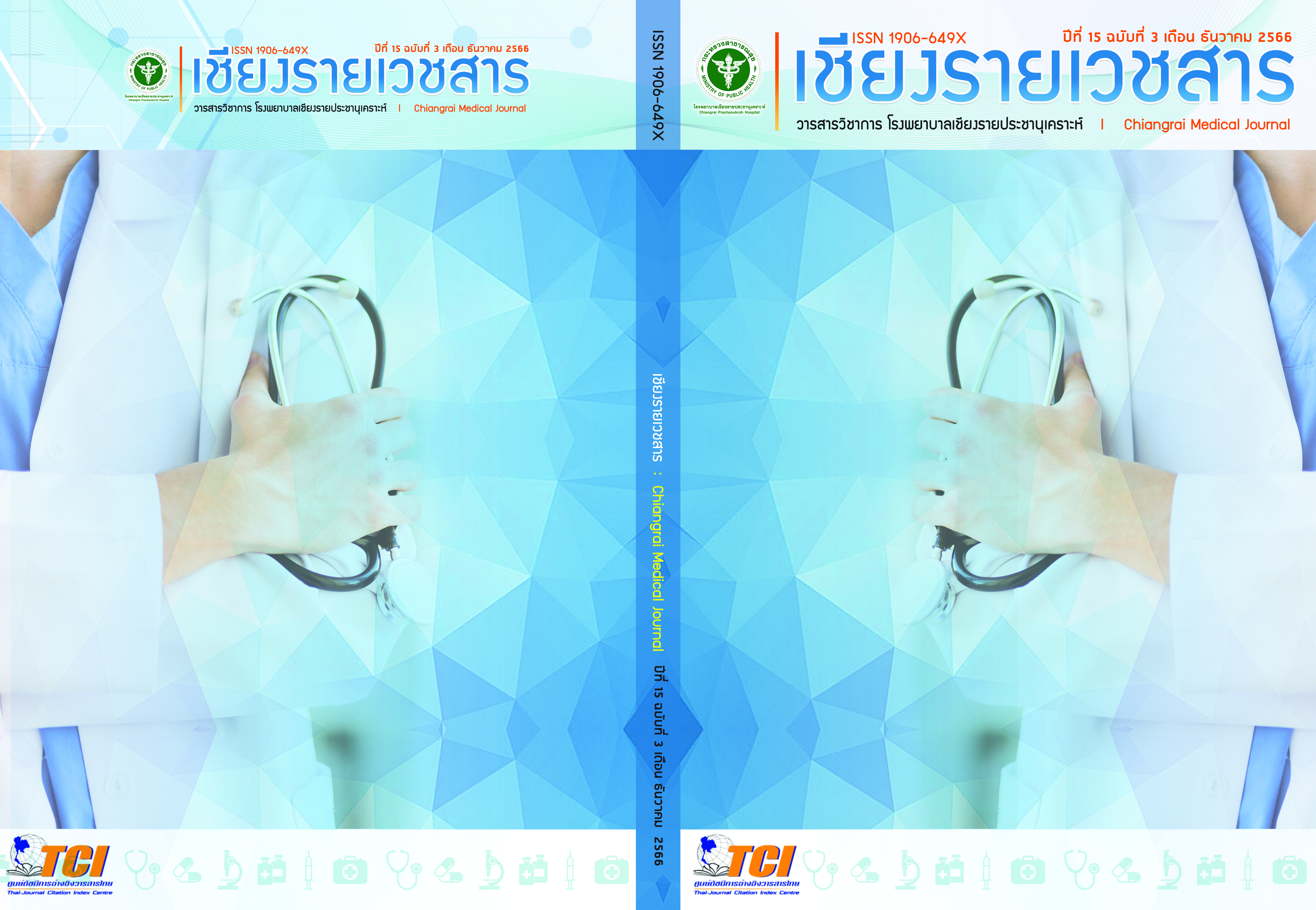ปัจจัยที่สัมพันธ์กับคุณภาพชีวิตที่เกี่ยวข้องกับสุขภาพของผู้ป่วยที่ได้รับการดูแลแบบประคับประคอง ในโรงพยาบาลลำปาง
Main Article Content
บทคัดย่อ
ความเป็นมา : คุณภาพชีวิตของผู้ป่วยถือเป็นหัวใจหลักของการดูแลแบบประคับประคอง ดังนั้นการทราบถึงปัจจัยที่สัมพันธ์กับคุณภาพชีวิตที่เกี่ยวข้องกับสุขภาพจะช่วยส่งเสริมคุณภาพการดูแลผู้ป่วยระยะท้ายให้มีคุณภาพชีวิตที่ดีขึ้นต่อไปได้
วัตถุประสงค์ : เพื่อศึกษาปัจจัยที่สัมพันธ์กับคุณภาพชีวิตที่เกี่ยวข้องกับสุขภาพของผู้ป่วยที่ได้รับการดูแลแบบประคับประคอง ในโรงพยาบาลลำปาง
ผลการศึกษา : ผู้ป่วยทั้งหมด 128 ราย เป็นเพศชาย 71 ราย (ร้อยละ 55.47) และเป็นผู้มีอายุ 71 ปีขึ้นไปมากที่สุด จำนวน 57 ราย (ร้อยละ 44.53) ส่วนใหญ่เป็นผู้ป่วยโรคมะเร็ง จำนวน 97ราย (ร้อยละ 75.78) ผลการศึกษาพบว่า ปัจจัยที่สัมพันธ์กับคุณภาพชีวิต ได้แก่ การรับรู้พยากรณ์โรค, การได้รับยามอร์ฟีน และคะแนน PPS ที่เพิ่มขึ้น
สรุปและข้อเสนอแนะ : การส่งเสริมให้ผู้ป่วยรับรู้พยากรณ์โรค การให้มอร์ฟินในผู้ป่วยที่มีอาการรบกวน และการดูแลให้ผู้ป่วยมีสมรรถนะทางร่างกายที่เพิ่มขึ้นเพื่อให้ผู้ป่วยสามารถช่วยเหลือตนเองได้มากที่สุด จะช่วยให้ผู้ป่วยมีคุณภาพชีวิตที่เกี่ยวข้องกับสุขภาพที่ดีขึ้น
Article Details

อนุญาตภายใต้เงื่อนไข Creative Commons Attribution-NonCommercial-NoDerivatives 4.0 International License.
เอกสารอ้างอิง
Connor SR, Bermedo MCS, editors. Global atlas of palliative care at the end of life. London: Worldwide Hospice Palliative Care Alliance; 2014.
Division of Non Communicable Disease. Thai NCD [Internet]. Nontaburi: Division of Non Communicable Disease; 2016 [update 2022 Jan 18; cited 2023 July 25]. Available from: http://www.thaincd.com.
Cancer today [Internet]. Lyon: International Agency for Research on Cancer; 2020 [cited 2023 July 25] Available from: https://gco.iarc.fr/today
The WHOQOL Group. The development of the World Health Organization quality of life asessment instrument (the WHOQOL). In: Orley J, Kuyken W, edtior. Quality of life assessment instruments: international perspectives. Berlin:Springer Verlag: 1994. p. 41-57.
Feeny D. A utility approach to the assessment of health-related quality of life. Med Care. 2000;38(9 Suppl):II151-4.
Photharos, N. Measurement of health-related quality of life. EAU Heritage Journal Science and Technology. 2016:10(3);36-43.
Janssen MF, Bonsel GJ, Luo N. Is EQ-5D-5L better than EQ-5D-3L? A head-to-head comparison of descriptive systems and value sets from seven countries. Pharmacoeconomics. 2018;36(6):675-97.
Puengsook W, Kanthawee P, Markmee P. factors associated with quality of life of among cancer patient with palliative care at the end of life residing in Chiang Rai Province. Nurs J Ministry Public Health 2019;29(2):116-28.
Prommarat C. Factors affecting the quality of life of the palliative care patient at palliative care clinic, Lamphun Hospital. Lanna Public Health Journal. 2020;16(1):70-81.
Gayatri D, Efremov L, Kantelhardt EJ, Mikolajczyk R. Quality of life of cancer patients at palliative care units in developing countries: systematic review of the published literature. Qual Life Res. 2021;30(2):315-43.
Pattanaphesaj J, Thavorncharoensap M. The Thai version of the EQ-5D-5L health questionnaire. HITAP. 2015;3(24).
Techakehakij W. Assessing health-related quality of life and utility in health research. Chiang Mai: Chiang Mai University Press; 2018.
Pattanaphesaj J. Health-related quality of life measure (EQ-5D-5L): measurement property testing and its preference-based score in Thai population: Mahidol University Salaya, Thailand; 2014.
Pattanaphesaj J, Thavorncharoensap M, Ramos-Goñi JM, Tongsiri S, Ingsrisawang L, Teerawattananon Y. The EQ-5D-5L Valuation study in Thailand. Expert Rev Pharmacoecon Outcomes Res. 2018;18(5):551-8.
Downing, G. Q&A manual, instructions & definitions for use of palliative performance scale (PPSv2). Canada: Victoria Hospice Society; 2020.
Lee H, Ko HJ, Kim AS, Kim SM, Moon H, Choi HI. Effect of prognosis awareness on the survival and quality of life of Ttrminally Ill cancer patients: a prospective cohort study. Korean J Fam Med. 2020;41(2):91-7.
Leppert W, Nosek K.. Comparison of the quality of life of cancer patients with pain treated with oral controlled-release morphine and oxycodone and transdermal buprenorphine and fentanyl. Curr Pharm Des. 2019;25(30):3216-24.


